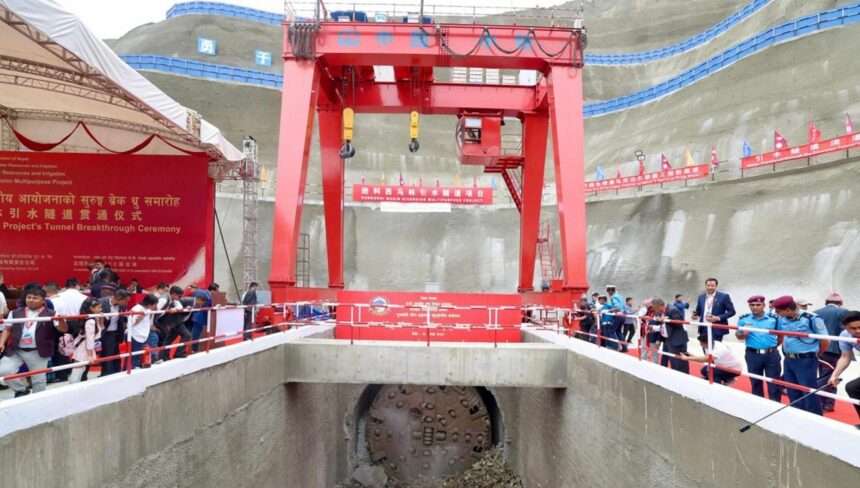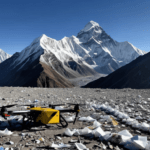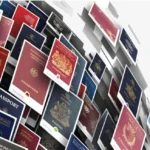After the successful inauguration of the Nagadhunga-Sisnekhola tunnel, the Sunkoshi-Marin Diversion Project’s tunnel marked Nepal’s second commercial tunnel route breakthrough just a few days ago. The tunnel’s construction was one of the major National Pride Projects under Sunkoshi-Marin Diversion Project while other projects are still under construction.
As we know, Nepal’s development projects often need to face delays, raising concerns about the efficiency of endeavors like the Sunkosi-Marin project, this project was completed 3 months ahead of the scheduled time. It is good news of course but the sad thing is the overall progress of the project, supposed to be completed by September 2027, has achieved only 30 percent progress so far. But anyway, the breakthrough of the tunnel sends a positive message, even though completion works are estimated to require an additional year.
About the Sunkoshi Marin Diversion Multipurpose Project (SMDMP)
In February 2021, the China Overseas Engineering Company won the contract to construct the tunnel for the Sunkoshi Marin multipurpose project by offering to do the work for Rs. 10.05 billion, nearly Rs. 6 billion less than the price quoted by the government.

The Chinese company has used a Tunnel Boring Machine (TBM) to cut the hills, making Sunkoshi Marin the second project after the Bheri-Babai Diversion Multipurpose Project in Surkhet to do so.
The tunnel is about 13.3 kilometers long, stretching from Kusumtar in Kamalamai Municipality-2 to Kandhungri in Sunkoshi Rural Municipality-7 in Sindhuli district. The tunnel project was part of the Sunkoshi-Marin Diversion Project, with an estimated overall cost of around Rs. 49.42 billion. The tunnel project alone cost approximately Rs. 10 billion, with the remaining budget allocated to other parts of the project. This tunnel will redirect part of the flow of the Sunkoshi River to the Marin River, a tributary of the Bagmati River, to irrigate farmlands in the central Tarai.
The final point of the tunnel was broken in the presence of Prime Minister Pushpa Kamal Dahal amid a function on Wednesday.
Related: Unlocking the Sky’s Secret Saviors: How Drones Could Be Mount Everest’s Lifeline
Why was this Tunnel Constructed?
The construction of the tunnel is a significant milestone for irrigation, electricity, and tourism. The project is aimed at diverting water from the Sunkoshi River to the Marin River, providing irrigation to 122,000 hectares of land in the Bara, Rautahat, Sarlahi, Mahottari, and Dhanusha districts in the Madhesh Province. This development is expected to substantially contribute to Nepal’s long-term food security and bring numerous other benefits to the region.
In addition, the project involves the critical aspect of power generation. The plan entails building a dam that is 30 meters high and 158 meters long on the Sunkoshi River at Kandhungri. This dam will release water into the Marin River at Kusumtar, which will generate 31 MW of electricity. However, this particular phase of the project is still in the pipeline and is expected to bring significant improvements in Nepal’s electricity capacity, leading to many associated advantages.
The Madan Bhandari Highway runs alongside the Sunkoshi-Marin Diversion Project, providing quicker travel from Hetauda to eastern Nepal and easy access to the capital. The region and the highway have the potential to attract both domestic and foreign tourists, making them popular destinations for sightseeing and research after the completion of the project. Therefore, the opening of the tunnel is great news not only for the people of Sindhuli but for all Nepalis.
Future Aspects of the Project
Prime Minister Dahal said that the completion of the National Pride project would irrigate a swathe of land in the Tarai and open up economic opportunities.

“This project will provide year-round irrigation to farmlands of five districts of the Madhesh province, and will contribute to the economy and also generate hydropower.” – Pushpa Kamal Dahal, Prime Minister of Nepal
As agriculture is the backbone of the Nepali economy, with a share of about a fourth of the GDP, PM Dahal said increased agricultural production would help the country be self-sufficient in food.
“Our Chinese companies utilized their strengths, offered Chinese expertise and innovative solutions, and teamed up with Nepalese technical experts to conquer challenges like tough geological conditions, logistical hurdles, and extended monsoon seasons. Despite these obstacles, we completed the project a year ahead of schedule, demonstrating China’s efficiency in delivering top-notch quality and meeting rigorous standards.” – Mr. Chen Song, Chinese Ambassador to Nepal
According to the environmental impact assessment of the Sunkoshi Marin diversion multipurpose project, year-round irrigation will be a boon to farmers as it will help boost production at a time when the country is facing a food deficit.









